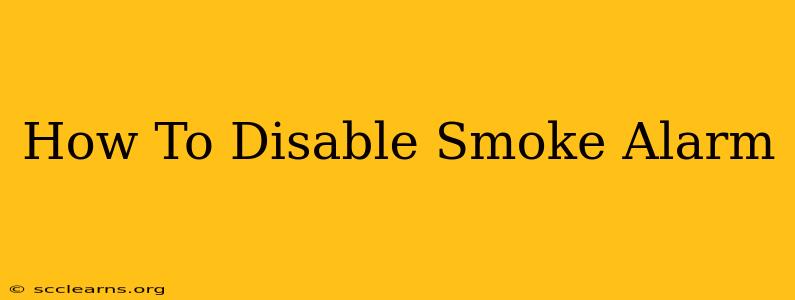Smoke alarms are critical life-saving devices, but there are times when you might need to temporarily disable one. Perhaps you're doing some cooking that's setting off the alarm, or you're carrying out renovations. However, disabling a smoke alarm should always be a last resort, and it's crucial to understand the risks involved and take necessary precautions. This guide explains how to disable a smoke alarm temporarily and safely. We will also cover important considerations to ensure your safety and the safety of your family.
Understanding Your Smoke Alarm
Before attempting to disable your smoke alarm, it's essential to understand its type and functionality. There are two primary types:
- Battery-Operated Smoke Alarms: These alarms run on batteries and usually have a simple test/hush button.
- Wired Smoke Alarms: These are hardwired into your home's electrical system and often have a separate battery backup. These can be more complex to disable.
Identifying your alarm type is the first step in understanding how to temporarily silence it.
How to Temporarily Disable a Smoke Alarm
Caution: Disabling a smoke alarm should only be done for short periods and only when absolutely necessary. Always prioritize your safety and the safety of others.
Disabling Battery-Operated Smoke Alarms
Most battery-operated alarms have a small button labeled "test" or "hush". Pressing and holding this button will usually silence the alarm temporarily. However, this will not disable the alarm's detection capabilities completely. It will only temporarily silence the alarm. The time it stays silenced varies by model, so consult your alarm's instructions.
Disabling Wired Smoke Alarms
Disabling wired smoke alarms is more complex and often involves accessing the electrical panel. This is not recommended unless you are an experienced electrician. Improperly disabling a wired alarm can be dangerous. It is best to consult a qualified electrician if you need to disable a wired smoke alarm.
Alternative Solutions to Disabling Your Smoke Alarm
Before resorting to disabling your smoke alarm, consider these safer alternatives:
- Ventilation: If cooking is triggering the alarm, ensure adequate ventilation by opening windows and using exhaust fans.
- Covering (Not Recommended): Although some might suggest covering the alarm, this is extremely dangerous as it completely disables the alarm's functionality. Do not cover the smoke alarm!
- Temporary Relocation: If possible, temporarily relocate to a different area while performing activities likely to trigger the alarm.
Important Safety Precautions
- Never completely disable a smoke alarm unless absolutely necessary.
- Only disable an alarm for the shortest possible time.
- Make sure to re-enable the alarm immediately after the triggering event has passed.
- Regularly test your smoke alarms (at least monthly). This ensures they are functioning correctly.
- Replace batteries in battery-operated alarms as recommended. Dead batteries can render your smoke alarm useless.
- Regularly maintain and replace your smoke alarms according to the manufacturer's instructions. Outdated alarms lose their sensitivity and may not alert you to a fire.
When to Call a Professional
If you are unsure about how to disable your smoke alarm or if you're having trouble with a wired alarm, always consult a qualified electrician or fire safety professional. Your safety is paramount.
This guide provides information on how to temporarily disable a smoke alarm, but remember that it's always best to keep your smoke alarms active and functioning correctly. They are essential life-saving devices that protect you and your family from the dangers of fire.

